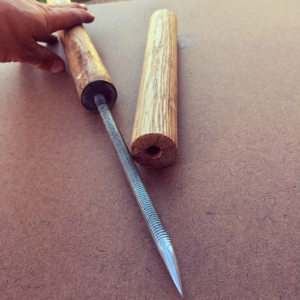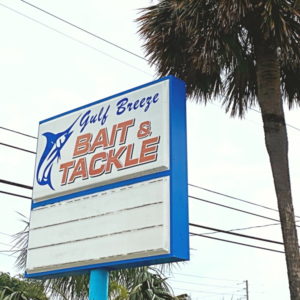*As an Amazon Associate I earn from qualifying purchases.

To catch speckled trout, find a grass flat in 2 to 5 feet of water. For best results, the flat should have deeper, and preferably moving, water close by. Cast out a live shrimp or soft plastic, such as the 4 inch Z-MAN DieZel MinnowZ Paddle Tail, and probe the area with your bait. Focus your efforts around any holes in the grass or along any edges or drop offs.
Move around until you find a school of feeding trout, as it’s more about finding them than it is about bait presentation. A stealthy approach is key so that you don’t shut down a feeding school.
When fishing from the beach, focus your efforts around cuts in the sandbars. Spotted seatrout are ambush predators that will use these high current areas to bring the bait to them, rather than them having to chase it down.
For additional information, and other ways to catch specks, continue reading below.
Speckled trout fishing is more about location than presentation. So, you may want to consider keeping any good trout holes you find a close secret!
General Information
(Cynoscion nebulosus)
Speckled trout, more properly termed “spotted seatrout”, are a member of the croaker, or drum family. They have a very noticeable yellow mouth with fang-like front canine teeth. These teeth, seen in the picture below, are used to bite prey in order to both stun it and hold onto it.
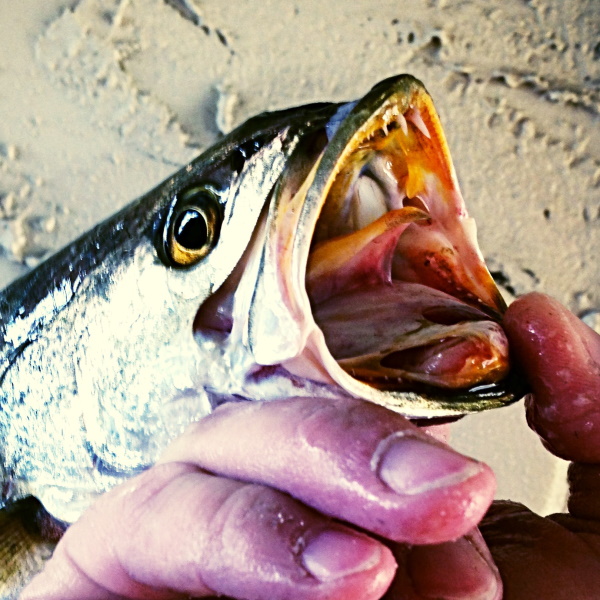
Seatrout are also commonly referred to as “specks”, “specs” or simply “trout”. Along the Gulf Coast, catching a trout, in combination with a redfish and a flounder in the same trip, is referred to as a “grand slam”.
Range
Speckled trout can be commonly found along beaches and in or near shallow inshore waters from Texas to Maryland. They are a very popular and wide ranging game fish. Although they are wide ranging, they are most heavily concentrated along the Gulf Coast region.
While specks will migrate to some degree during their spawn, they are largely a “local” fish that tends to live out their entire lives in the same general area. This doesn’t quite hold true in their northernmost range along the Atlantic, where they will migrate south in search of warmer water.
Diet
Trout forage on shrimp, finger mullet, menhaden, pinfish, minnows, other small fish and even small crabs. Larger “gator trout” will tend to eat larger prey such as mullet and small croakers. Therefore, using bigger lures does sometimes translate into more big fish.
Habitat
Trout are a schooling fish that likes to frequent areas where current exists, such as where there is some contour change on the bottom, or a point or bend.
You’ll often find trout along grass flats and other marshy areas near deeper water. They are not particularly drawn to hard bottom areas, but they do frequent locations that harbor oyster beds, as they are attracted to the bait that is found there.
Speckled trout are also found along the beach when pods of baitfish are around. However, in wintertime they will be more commonly found inshore.
In their northern ranges on the Atlantic coast, they may migrate south to warmer waters, depending how far north you are fishing. So, they may not be available to you year round in some of the northern reaches of their range.
Grass flats in 2 to 4 foot of water near deeper water, particularly near moving water, are great locations for trout.
Size
Spotted seatrout typically range from 1 to 3 pounds, but can commonly get to 5 pounds. The world record is 17 pounds 7 ounces. These larger specs over 5 pounds are often referred to as “gator trout“.
Males don’t live as long as females. Therefore, most all large trout weighing over 5 pounds are females!
State Records For Speckled Trout
| STATE | RECORD | |
|---|---|---|
 | Texas | 15.6 lb. |
 | Louisiana | 12.38 lb. |
 | Mississippi | 10 lb. 10 oz. |
 | Alabama | 12 lb. 4 oz. |
 | Florida | 17 lb. 7 oz. |
 | Georgia | 9 lb. 7 oz. |
 | South Carolina | 11 lb. 13 oz. |
 | North Carolina | 12 lb. 4 oz. |
 | Virginia | 16 lb. |
 | New Jersey | 11 lb. 2 oz. |
Best Times To Target Trout
Seasons
Spring is the most productive time of the year to target specks, as they seem quite hungry during their annual spawn. Seatrout generally have a long spawning season lasting through spring and into summer, and even longer in some areas. Fall is also a great time for trout. We will further discuss seasonal trout fishing below.
Approximately 65 -75 degrees is an ideal temperature range for trout, but they can be caught successfully outside that range. If a cold front hits, you may have to try a little deeper water than where they were prior to the cold weather.
Beach Fishing Opportunity
While trout are primarily considered an inshore species, depending on the time of year, they can also be caught from beaches. In fact, from northern Texas to the panhandle of Florida, they can be pulled from the surf year round. Peak times for beach fish here are spring and fall.
Time Of Day
You’ll have best luck with trout if you focus your efforts around times of low light, such as dusk and dawn. Trout seem to prefer to feed in the early morning and late evening hours.
Tide Movements
Besides focusing your efforts around low light, you’ll also want to target them during a moving tide when possible. Any time you can line up low light conditions with a moving tide, that is ideal.
Pay close attention to tide changes, and focus your efforts around maximum movements, especially when they line up with low light conditions.
Spring
Spring is the best time of year to target speckled trout. They will move into the shallows as the water begins to warm up. In the warmer waters you can speed up your retrieve to entice more strikes. Target shallow grass flats, and keep moving until you find the fish.
During this time of year, you can also catch them right off the beach. Cast to the first sandbar off the beach and work your bait back to shore. Trout can be surprisingly close to the beach, so work the lure all the way to the water’s edge.
Use smaller profile baits earlier in the year when the bait in the water is smaller, and move up to larger baits as the year progresses.
Summer
During really hot weather trout will seek out cooler water temps by moving to deeper areas. Focus your efforts in the shallows during times of low light, such as morning and evening. Then, when the temps heat up, try moving to nearby deeper water around some type of structure, such as grass or rocks.
Fall
Fall is an excellent time for speck fishing. Before the water cools way down in winter, you’ll find trout in the same sorts of places you found them in springtime and early summer.
Winter
Winter seems to be a great time to catch larger trout. As the water temps plummet, trout will begin moving out of the shallows and into deeper water areas where they can find warmer water. This could be into the ends of rivers, or into deeper bays, or anywhere else that deeper water is available nearby.
While most trout will reside in these areas of deeper water in wintertime, they will venture into the shallows with temperature fluctuations. Trout will follow bait up onto shallow mud flats during the day where the water has been warmed by the sun.
A slow retrieve is generally best for trout in general, but this is particularly true in the winter.
Seatrout are sensitive to cold weather and are thus more susceptible to fish kills than other species. Therefore, unusually harsh winters can adversely affect subsequent years productivity in a given area.
Where To Find Speckled Trout
Speckled trout are ambush feeders that will first of all, be found where the bait is, and second of all, where they can sneak attack that bait. So, you should be thinking structure and current. Those are 2 key components to the best trout spots. Of course, water temps will need to be appropriate as well, but if the bait is there, the trout will likely be there. Below are many examples of solid places you can consistently find fish.
- Passes
- Grass Flats
- Oyster Bars
- Docks
- Beaches
- Jetties
- Points
- Creek Mouths
- Submerged Humps
Trout are commonly found around passes, grass lines, oyster bars, docks, and even beaches. Other solid options are jetties, points, creek mouths and submerged humps. They tend to frequent these types of areas so they can ambush the small baitfish, shrimp and other crustaceans that live and hide in those places. Seatrout will also move up onto shallow grass flats to feed when the tide rises.
Trout are of the same fish family as red drum and will be often found in the same areas. You can expect to catch both species when fishing for trout.
How To Catch Spotted Seatrout
There are many ways you can effectively pursue speckled trout, so you’ll have to find which tactic is most effective in your area. It mostly comes down to personal preference as to which style you prefer. Below are some different ways that you can successfully target trout. Choose your preference below, or try them all to see what style is most enjoyable to you.
Speckled Trout Fishing From A Boat
Fishing from a boat or kayak is certainly the most versatile way to pursue trout. Because you have to find them before you can catch them, having a boat is a huge asset.
The key things to keep in mind for a boat fishermen is to keep quiet, cast far and keep searching until you find fish.
Besides “conventional” fishing from a boat, having a vessel also opens up a couple of tactics not available to those without at boat, such as dock light fishing and drift fishing, discussed below.
Dock Light Fishing For Trout
Fishing docks at night under the lights is a productive way to target these fish. Lights attract bait and in turn, the bait attracts trout. Night fishing can be done from boat, kayak or by foot, if you have permission to fish a dock.
With less boat traffic, cooler temps, and less fishing competition, night fishing can be a more relaxing affair. However, the stillness commands a stealthy approach, and you may even have to let a dock rest after much commotion, such as reeling in a few fish.
Try to find docks with deeper water nearby and work them by quietly retrieving soft plastics or live baits slowly through the light. Either reel the bait through the lighted area, or allow the current to drift your bait into the light.
A light 1/8 oz. bait or lure setup is good. There is no need for a gaudy or loud presentation because you aren’t trying to attract fish from a distance. They are already feeding under the light.
Wade Fishing For Speckled Trout
Wade fishing is another popular option in some areas. Trout are a very spooky fish and wading will allow you a much stealthier approach than a boat will. Good areas for wading are shallow grass flats or around oyster bars. Low tide is typically better, as it will eliminate some of the water from your hunt and pack the fish into smaller areas.
Take a backpack, wading belt, fanny pack, or a life jacket to hold your gear. You’ll want to only bring one rod and reel. Artificials are the preferred way to go when wade fishing. You can use waders or just wading boots if the water is warm enough. For safety purposes, it’s best if you wear a life jacket, and they can double to hold your gear.
Some random gear you will need when wade fishing is pliers, a net or fish grippers, sunscreen, a hat, plenty of baits, and a long stringer if you intend to keep fish.
Don’t forget to do the stingray shuffle when wade fishing!
Trout are a wary species and will shut down if there is too much noise. Wade fishing can be extremely effective since your presence is far less noticeable than in a boat. Long casts are also key when fishing for trout.
Surf Fishing For Speckled Trout
Hit the beach in summer when the trout are around, and look for cuts or rips in the sandbars. Specks are ambush feeders and will take advantage of their surroundings to bring the bait to them. This is what cuts in the bar will do. The current will sweep bait to waiting trout. As with most species, moving tides are best.
The low light periods of dusk and dawn are best for trout in general, but it’s particularly important on the beach. When the sun gets high, trout may move to deeper water and out of your casting reach.
Topwaters, jigs and jerkbaits are all good options from the beach.
Trolling Or Drifting For Trout
Trolling for speckled trout is pretty straightforward. When in a kayak or boat, toss out a sub-surface bait a good distance, stick your rod in a rod holder or hold onto it. You’ll need to slowly drift, troll or paddle along until you get bit. Use your speed and the amount of line you have out in order to probe different depths effectively.
Set your drag tight enough to set the hook, but don’t lock it all the way down so that the hook rips out. Canals, grass flats and any other place you would normally find trout is a good area to try to drift for trout. Remain particularly focused as you pass over any depth change or ledge.
This is a good method for locating trout when you don’t know where they are. Then you can slow down and fish the area “normally” if so desired.
Best Natural Baits For Speckled Trout
Live shrimp is the best bait for speckled trout, but there are some other effective options. When shrimp are not around, small fish, such as mullet, pogies and greenbacks (threadfin herring), are great baits to use. While not as effective as live, fresh dead shrimp is also an effective bait, particularly along the Gulf Coast.
- Live Shrimp
- Finger Mullet And Other Small Bait Fish
- Fresh Dead Shrimp
- Squid
- Worms
Best Natural Bait Rigs For Speckled Trout
Pompano rigs and sized down fish finder rigs both work to catch trout, but probably the most popular method is to use a popping cork. There are many baits you can fish effectively under a popping cork. Live shrimp, fresh dead shrimp, soft plastics and Gulp! baits to name a few. More discussion about popping corks below.
Hook Only
A simple hook with a shrimp or small bait fish on it can be very effective for trout. Freeline your baits near openings in grass beds, or other structure.
Popping Corks

* Click image above to view prices on Amazon
Using a popping cork is very effective for trout. They are really good around areas where your bait would otherwise constantly keep hanging up, such as over grass or rocks. They are also a great option when using live bait.
A popping cork should be fished approximately 1/4 to 1/2 the distance of the depth of water you are fishing. There should typically be 18-24″ of leader material hanging below your popping cork.
Bait your cork with a jig or live bait and pop the cork periodically during the retrieve. Jerk it, and let it sit for a bit. Vary your frequency of pops and how hard you pop it to find what works. Remember, with trout, slower is usually better.
Best Lures For Speckled Trout
When it comes to speckled trout, for most anglers it’s a lure fishing endeavor. Their ready acceptance of artificials is part of what makes the speck such a popular game fish.
Lures that mimic the aforementioned natural baits, of shrimp and small fish, are usually the best bet. 3″ to 4″ plastic shrimp, plastic fish imitators, as well as topwater baits, are all perfect choices.
The Berkey Gulp! 3″ Shrimp, linked below, is a great option for beginners. Choose the “New Penny” color.

* Click image above to view prices on Amazon
DOA shrimp, Z-man shrimp, or some other plastic shrimp imitator on a jig head are all good baits. Possibly an even more effective bait is the paddle tail soft plastic. Plastic grubs also work well, as do various topwaters, particularly walk-the-dog type baits.
I listed a good selection of proven trout baits below. For any lures that don’t already have scent included into it’s design, it’s not a bad idea to add some sort of external scent to your bait.
Use larger profile baits to increase your odds at larger fish.
These are all GREAT artificials for speck fishing
- DOA Shrimp
- Curly Tail Grubs
- Matrix Shad
- MirrOlure Marsh Minnow
- Berkley Gulp! Shrimp 3″
- Berkley Gulp! Jerk Shad
- DOA Cal Shad
- Down South Lures Shad
- Z-MAN DieZel MinnowZ Paddle Tail Swimbaits
- Bass Assassin Saltwater Sea Shad 4″
- Zara Spook Jr.
- MirrOlure Mirrodine
- MirrOlure 52MR
- Rapala X-rap
- Spoons
- Yozuri Crystal Minnow
- MirrOlure Paul Brown
Mirrolure Mirrodine
Mirrolures are so popular for speckled trout fishing, they deserve their own breakout. These hard baits can be used effectively any time of the year.
Mirrodines are a suspending twitch bait that is deadly on trout. The suspending ability allows you to work the bait in varying depths of the water column. It also allows you to pause the bait almost motionless which can entice strikes from following fish.
Besides the action of the bait, it also closely resembles many of the baits commonly pursued by specks. When it comes to size and color pattern, try to match the hatch with whatever bait you see around.

* Click image above to view prices on Amazon
Soft Plastic Paddletails
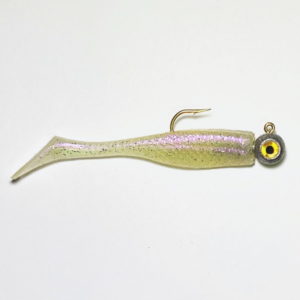
The most consistently reliable bait that I know of is a soft plastic paddle tail jig, such as the Matrix Shad pictured above. Many of the bites come on the drop, so bounce it along the bottom. If that doesn’t produce, you can try swimming it slow and steady which can also be very effective.
Jig Head Selection
You’ll of course need a jig head to go along with your soft plastics. Anywhere from 1/16 ounce to 1/2 ounce jig heads will work for trout, but the most commonly used jig heads are from 1/8-1/4 ounce. The weight of your jig head depends on the water depth and the current where you’re fishing. For shallower water with less current, go lighter. For deeper water or more current, go with a heavier jig head. Don’t get too hung up on jig head color, as pretty much any color is fine, even a standard lead head.
Color Selection
Many, many colors work well for trout lures. Penny, bone, white, pink, chartreuse and silver are all good colors. Color selection will depend on water conditions as well as whatever the predominant forage is. For darker waters, go with brighter colors such as pink or chartreuse. More natural colors, such as white, tend to work better in clear water situations.
Retrieving Jigs
You can fish plastic jigs by slowly bumping them off the bottom, by using a slow and steady retrieve, or by suspending them under a popping cork. When working soft plastics on the bottom, try to mimic a shrimp. Regardless of your method, you should work your jig slowly.
Plastic Shrimp

* Click image above to view prices on Amazon
Plastic shrimp can be much more efficient than live shrimp. Although live shrimp are an excellent choice, they are expensive and you’ll constantly need to re-bait. If you are around a lot of trout, you don’t need live bait to catch trout. The DOA shrimp is a long-standing proven winner in this category. You can fish this lure with confidence.
Topwater Baits
Finally, topwater baits can be great fun when speck fishing. Walk-the-dog style topwater baits, such as the Zara Spook, Zara Puppy, or MirrOlures are very effective for spotted seatrout. As long as there isn’t a lot of surface grass around, topwaters are deadly. White colors are good. Don’t stop your bait if a fish is trailing, keep it coming. Topwaters are always a great choice in low light periods.
Rod, Reel and Line
All you need for trout is a 6.5 to 7.6 foot rod with about a 3000 sized reel. Light to medium action rods rated up to 3/8 ounce are good choices. Even on the beaches, you won’t necessarily have to cast that far out, so a really long rod isn’t really necessary for trout.
Although braided line is just fine for trout fishing, 8 to 12 lb. monofilament is perhaps a better main line option. Trout have soft mouths, so the stretch that you get with monofilament line helps prevent the hook from tearing free. Don’t go overboard on line size, as trout have good eyesight and can be line shy.
If you use braid for your main line, it’s generally best if you tie on a mono or flouro leader. For this connection, a uni to uni knot is a good choice, and it’s easy to tie.
Catching And Landing Specs
When working an area with current you need to position yourself down-current and toss your bait up-current. This allows you to perform a more natural presentation. Because trout are ambush feeders, they’ll face up-current and wait for bait to be pushed to them.
Trout may not always immediately take a bait, so you might have to pause before a hookset. This is because trout use their front fanglike teeth to sometimes stun their prey before eating it. Therefore, you may have to pause, and let them fully take in the bait before applying a gentle hookset. Don’t set the hook too hard, or you’ll often rip the hook free of their mouth. Light hook sets are key.
Other times, specks will aggressively take a bait, and while they are not a particularly powerful fish, they do thrash a lot when retrieving them. Due to their soft mouths and aggressive fight, you have to take care to not pull the hook when reeling them in.
Finally, try to keep slack out of your line on the retrieve, whether that be a steady retrieve or a bottom bouncing retrieve.
Use wet hands when handling trout, so as to not damage their slime coat. Rubber coated nets are also a good option.
Are Speckled Trout Good To Eat?
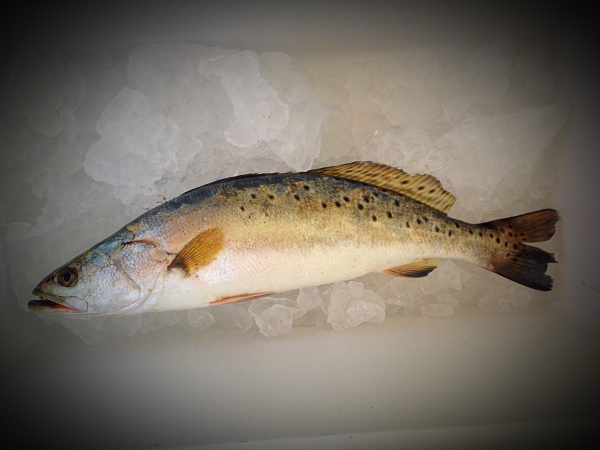
Yes, most definitely yes, speckled trout are a great eating fish. However, it’s very important to cool your catch down as soon as possible for best flavor. Trout have a delicate flesh that is somewhat fragile, and can spoil more rapidly than other species if not cared for properly.
The meat of a trout lends itself to being cooked all sorts of ways, but I usually just fry it.
Conclusion
Speckled trout are one of the most popular inshore species for a reason, several reasons actually. They are plentiful, available year round, they readily take artificials, and are excellent to eat. Go out, find yourself a nice grass flat, and give them a go.
If you enjoyed this article, you might also be interested in my writeup on How To Catch Bull Reds or How To Catch Sheepshead.

